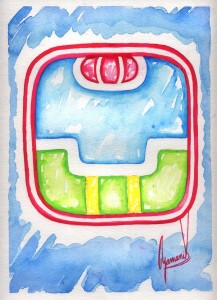1 K’at – Creation to Realization for Cholq’ij New Year
 K’AT This Ch’umil represents the ties, the entanglements, everything that traps us, that does not allow us to be free, that limits our spontaneity and our determination. It is called the net. These limitations come from the rules that we have accepted ―some of them completely absurd― which come from our family, our school, the system, or which are created by ourselves. It is in K’at that we must untie the knots of our reality and break the limits that prevent our development. We are so tied up to this reality that we cannot see that everything is an illusion which we can configure. We have learned to configure things the way we see them, and these are a reality of shape, size, weight, and dimension. It is the synaptic creation we human beings have formed, every being that has existed, exists, or will exist. All of this is a great illusion. We are so deeply involved in the system that we do not dare to break this. Magic, vision, healing; they are only believing that you can do it. The important thing is to remember that this is a reality that we create. The elders visualized this thousands of years ago, they defined the energies that affect reality and because of these they gave each day a space, a form; they were observing for thousands of years and they saw which were the energies of the beginning, of the path… K’at is twining, it is catching, but the most important aspect of K’at is that people break and untie the knots; it is realizing that this is knotted and we have to untie the knots to free ourselves.
K’AT This Ch’umil represents the ties, the entanglements, everything that traps us, that does not allow us to be free, that limits our spontaneity and our determination. It is called the net. These limitations come from the rules that we have accepted ―some of them completely absurd― which come from our family, our school, the system, or which are created by ourselves. It is in K’at that we must untie the knots of our reality and break the limits that prevent our development. We are so tied up to this reality that we cannot see that everything is an illusion which we can configure. We have learned to configure things the way we see them, and these are a reality of shape, size, weight, and dimension. It is the synaptic creation we human beings have formed, every being that has existed, exists, or will exist. All of this is a great illusion. We are so deeply involved in the system that we do not dare to break this. Magic, vision, healing; they are only believing that you can do it. The important thing is to remember that this is a reality that we create. The elders visualized this thousands of years ago, they defined the energies that affect reality and because of these they gave each day a space, a form; they were observing for thousands of years and they saw which were the energies of the beginning, of the path… K’at is twining, it is catching, but the most important aspect of K’at is that people break and untie the knots; it is realizing that this is knotted and we have to untie the knots to free ourselves.
Wajxaqib’ (8) B’at’z – The Cholq’ij New Year
According to the Maya, the world was created in one Mayan month (twenty days). The process of creation begins on Jun (1) B’atz and ends on the day Wuqub’ (7) Tz’i’, completing the first twenty days of the Cholq’ij (Calendar of Life). After this final day of creation, the day Wajxaqib’ (8) B’atz’ arrives, which is considered the Cholq’ij New Year. When Maya people celebrate the Cholq’ij new year, they are celebrating that the creation of the world has been fulfilled, and the beginning of a new cycle of 260 days.
We are living in the time of the Job’ Ajaw, or Fifth Sun which we entered on December 21, 2012. This epoch is related to the element Ether and to the fifth dimension. We have entered a time of greater awareness, in which we are witnessing socio-economic changes – but these changes don’t happen overnight. We are only now beginning to see them. The energy of the Ch’umilal, or signs of the Maya Cholq’ij Calendar, have the same meaning we have been sharing, but now their energy resonates more with the spiritual power that comes with them. The concatenation of the energies that each of the Ch’umilal represents is the guide of the Creation. It influences us throughout the cycle of our life and the cycle of Mother Earth. By working with each of the days we will connect to the spiritual energy of the twenty Ch’umilal to be in harmony with each of them.
You can follow Carlos’s guide to more deeply understanding and connecting with the energies of the twenty days leading up to the Cholq’ij New Year in the Daily Ch’umil section of the website, or by subscribing to the newsletter or following Saq’ Be’ on social media.
- 6 Kan ~ Today’s Ch’umil - June 27, 2020
- 5 K’at ~ Today’s Ch’umil - June 26, 2020
- 3 Iq’ ~ Today’s Ch’umil - June 24, 2020


Thank you to Saq Be/Sacred Road – do the elders have instructions
as to how to untie the knots and how they have carefully untied these knots to
every thing unwanted and no longer serving liberatoin?
Sometimes it is as simple as literally tying knots into a piece of rope, while focusing on your problems while you tie them, then liberating those problems later by untying them with that intention. A symbolic method that helps to focus and align intent with the power of the day’s energy. Hope that helps!
thank you!!